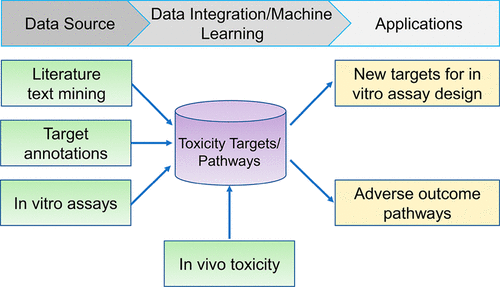当前位置:
X-MOL 学术
›
Chem. Res. Toxicol.
›
论文详情
Our official English website, www.x-mol.net, welcomes your
feedback! (Note: you will need to create a separate account there.)
Systematic Identification of Molecular Targets and Pathways Related to Human Organ Level Toxicity
Chemical Research in Toxicology ( IF 3.7 ) Pub Date : 2020-11-29 , DOI: 10.1021/acs.chemrestox.0c00305 Tuan Xu 1 , Leihong Wu 2 , Menghang Xia 1 , Anton Simeonov 1 , Ruili Huang 1
Chemical Research in Toxicology ( IF 3.7 ) Pub Date : 2020-11-29 , DOI: 10.1021/acs.chemrestox.0c00305 Tuan Xu 1 , Leihong Wu 2 , Menghang Xia 1 , Anton Simeonov 1 , Ruili Huang 1
Affiliation

|
The mechanisms leading to organ level toxicities are poorly understood. In this study, we applied an integrated approach to deduce the molecular targets and biological pathways involved in chemically induced toxicity for eight common human organ level toxicity end points (carcinogenicity, cardiotoxicity, developmental toxicity, hepatotoxicity, nephrotoxicity, neurotoxicity, reproductive toxicity, and skin toxicity). Integrated analysis of in vitro assay data, molecular targets and pathway annotations from the literature, and toxicity–molecular target associations derived from text mining, combined with machine learning techniques, were used to generate molecular targets for each of the organ level toxicity end points. A total of 1516 toxicity-related genes were identified and subsequently analyzed for biological pathway coverage, resulting in 206 significant pathways (p-value <0.05), ranging from 3 (e.g., developmental toxicity) to 101 (e.g., skin toxicity) for each toxicity end point. This study presents a systematic and comprehensive analysis of molecular targets and pathways related to various in vivo toxicity end points. These molecular targets and pathways could aid in understanding the biological mechanisms of toxicity and serve as a guide for the design of suitable in vitro assays for more efficient toxicity testing. In addition, these results are complementary to the existing adverse outcome pathway (AOP) framework and can be used to aid in the development of novel AOPs. Our results provide abundant testable hypotheses for further experimental validation.
中文翻译:

系统识别与人体器官水平毒性相关的分子靶点和途径
导致器官水平毒性的机制知之甚少。在本研究中,我们采用综合方法推断化学诱导毒性涉及的分子靶点和生物学途径,涉及八个常见的人体器官水平毒性终点(致癌性、心脏毒性、发育毒性、肝毒性、肾毒性、神经毒性、生殖毒性和皮肤毒性)。毒性)。体外分析数据的综合分析、文献中的分子靶点和通路注释,以及来自文本挖掘的毒性-分子靶点关联,结合机器学习技术,用于生成每个器官水平毒性终点的分子靶点。共鉴定了 1516 个毒性相关基因,随后分析了生物通路覆盖率,p值<0.05),每个毒性终点的范围从3(例如,发育毒性)到101(例如,皮肤毒性)。本研究对与各种体内毒性终点相关的分子靶点和途径进行了系统和全面的分析。这些分子靶点和途径可以帮助理解毒性的生物学机制,并作为设计合适的体外试验以进行更有效的毒性测试的指南。此外,这些结果是对现有不良结果途径 (AOP) 框架的补充,可用于帮助开发新的 AOP。我们的结果为进一步的实验验证提供了丰富的可检验假设。
更新日期:2020-11-29
中文翻译:

系统识别与人体器官水平毒性相关的分子靶点和途径
导致器官水平毒性的机制知之甚少。在本研究中,我们采用综合方法推断化学诱导毒性涉及的分子靶点和生物学途径,涉及八个常见的人体器官水平毒性终点(致癌性、心脏毒性、发育毒性、肝毒性、肾毒性、神经毒性、生殖毒性和皮肤毒性)。毒性)。体外分析数据的综合分析、文献中的分子靶点和通路注释,以及来自文本挖掘的毒性-分子靶点关联,结合机器学习技术,用于生成每个器官水平毒性终点的分子靶点。共鉴定了 1516 个毒性相关基因,随后分析了生物通路覆盖率,p值<0.05),每个毒性终点的范围从3(例如,发育毒性)到101(例如,皮肤毒性)。本研究对与各种体内毒性终点相关的分子靶点和途径进行了系统和全面的分析。这些分子靶点和途径可以帮助理解毒性的生物学机制,并作为设计合适的体外试验以进行更有效的毒性测试的指南。此外,这些结果是对现有不良结果途径 (AOP) 框架的补充,可用于帮助开发新的 AOP。我们的结果为进一步的实验验证提供了丰富的可检验假设。











































 京公网安备 11010802027423号
京公网安备 11010802027423号